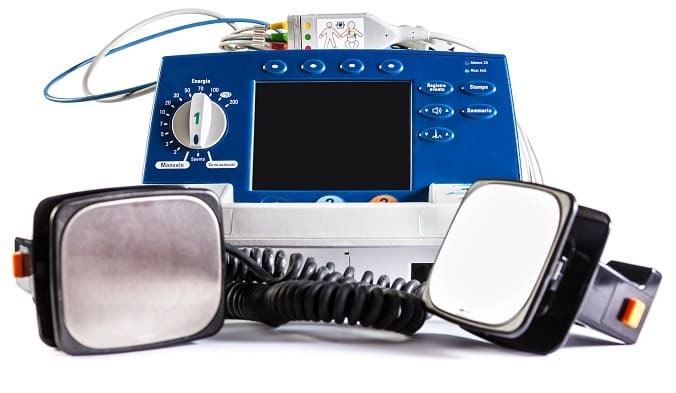
 Data Structure
Data Structure Networking
Networking RDBMS
RDBMS Operating System
Operating System Java
Java MS Excel
MS Excel iOS
iOS HTML
HTML CSS
CSS Android
Android Python
Python C Programming
C Programming C++
C++ C#
C# MongoDB
MongoDB MySQL
MySQL Javascript
Javascript PHP
PHP
- Selected Reading
- UPSC IAS Exams Notes
- Developer's Best Practices
- Questions and Answers
- Effective Resume Writing
- HR Interview Questions
- Computer Glossary
- Who is Who
What is the full form of ICD?
Introduction
Implantable Cardioverter Defibrillator (ICD) is a small electronic device surgically placed beneath the skin of the chest to continually monitor the heart's rhythm and shock the heart as required. It is primarily used to treat heart arrhythmias that might cause rapid cardiac arrest, such as ventricular tachycardia and ventricular fibrillation, which can cause the heart to beat excessively fast or irregularly.

The heart is shocked with a regulated electrical shock by the ICD to get it back into rhythm and stop sudden cardiac death. For those who are at high risk of developing arrhythmias or who have previously suffered a life-threatening arrhythmia, it is a crucial kind of treatment.
Purpose of Implantable Cardioverter Defibrillator
An implanted cardioverter defibrillator (ICD) is primarily used to prevent sudden cardiac death in those who are at a high risk of developing potentially fatal heart arrhythmias. The system continually checks the heart's rhythm and, if required, shocks the heart with electricity to get it back to normal.
ICDs are often advised for those who have had cardiac arrest, sustained ventricular tachycardia, or are at a high risk of doing so owing to underlying heart disease. They are also advised for those who are at risk of developing arrhythmias after having a prior cardiac procedure like angioplasty or coronary artery bypass grafting.
By lowering the risk of sudden cardiac death, ICDs may considerably improve the prognosis for those with arrhythmias. They may also enhance quality of life by lowering worry and panic brought on by the potential for abrupt cardiac arrest.
Implantation of Implantable Cardioverter Defibrillator
A skilled cardiac electrophysiologist or a cardiac surgeon commonly implants implantable cardioverter defibrillators (ICDs) in a hospital environment. Although general anaesthesia may be required in certain individuals, the implantation process is often carried out under local anaesthetic and mild sedation.
In order to create a pocket for the ICD device during the implantation surgery, a tiny incision is made in the chest. A lead or leads?thin, insulated wires with electrodes on the ends?are inserted into the heart via a vein and fastened to its chambers. The ICD device is then inserted into the chest pocket that has been formed, and the leads are attached to it. After being implanted, the gadget is set up to monitor the heart's rhythm and, if necessary, shock the patient with electricity.
The patient will be observed in the hospital for a few days after the surgery to make sure the ICD is working well and there are no issues. For a few weeks following the treatment, patients are often recommended to refrain from engaging in heavy physical activity to give the incision site time to heal. Regular check-ups with the doctor or a cardiac electrophysiologist are required to make sure the ICD is operating properly and to keep tabs on the patient's heart health.
Risks and Complications of Implantable Cardioverter Defibrillator
Implanting an implanted cardioverter defibrillator (ICD) has various risks and possible problems, much like any surgical surgery. The following are a few potential dangers and issues connected to ICD implantation

Infection Every surgical operation, including the insertion of an ICD, carries the risk of infection. Antibiotics are given to patients before the surgery to lower the risk of infection, but there is still a very little chance of infection at the incision site or around the device.
Bleeding or Bruising At the location of the incision, bleeding or bruises are frequent, but in rare circumstances, severe bleeding might happen and need medical attention.
Damage to Blood Vessels, Nerves or other Organs Wires are inserted into the heart during the surgery via blood arteries, which might harm other organs, nerves, or blood vessels.
Lead Complications The ICD may give incorrect or insufficient treatment as a result of broken or malfunctioning leads. Complications with lead may be needed for lead replacement or relocation.
Device Failure Technical issues may cause the ICD device to malfunction or fail, which might prevent it from performing as intended.
Allergic Reaction Patients may sometimes have an adverse response to the materials used to make the ICD device.
Psychological Impact In addition to worries about receiving a shock from the ICD, some patients may develop anxiety or sadness as a result of having one.
To decide whether an implanted ICD is the best choice for your specific circumstances, it's crucial to go through the risks and advantages with your doctor.
Conclusion
In conclusion, ICD implantation is a safe and efficient treatment, although there are always possible dangers and side effects with surgery. In order to guarantee the device functions well and to lower the risk of problems, patients who get an ICD must also undertake certain lifestyle modifications.
FAQs
Q 1 Can an ICD be turned off or removed?
Ans: Yes, it is possible to disable or remove an ICD; however this should only be done with the help of a medical expert. Before taking this action, one should think about alternate therapy since turning off or deleting an ICD might have catastrophic repercussions.
Q 2 What lifestyle changes are necessary after receiving an ICD?
Ans: Patients who have an ICD should refrain from certain activities that can cause the device to malfunction, such as strenuous exercise, powerful magnetic fields, and exposure to electrical sources. Prior to any medical operations, they should alert the healthcare professionals about the device's existence.
Q 3 Who is a candidate for an ICD?
Ans: Candidates for an ICD include those with a history of cardiac arrest, sustained ventricular tachycardia, or who are at a high risk of experiencing these diseases owing to an underlying heart ailment.

